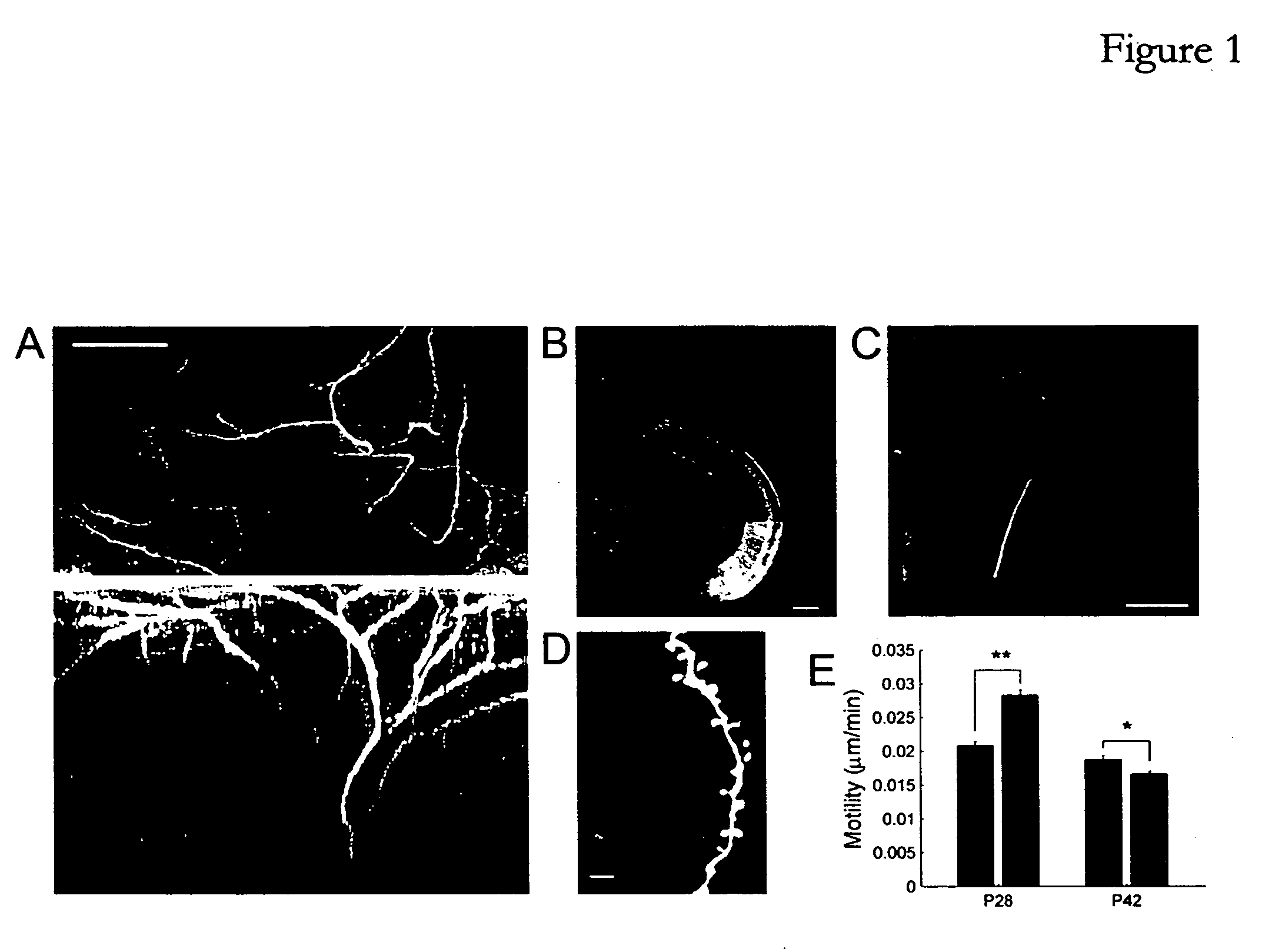Compositions and methods for enhancing structural and functional nervous system reorganization and recovery
a functional nervous system and structural reorganization technology, applied in the field of structural and functional nervous system reorganization and recovery, can solve problems such as cognitive impairment, promote structural reorganization of synaptic connections, promote the degradation of components, and increase the formation of new synaptic connections
- Summary
- Abstract
- Description
- Claims
- Application Information
AI Technical Summary
Benefits of technology
Problems solved by technology
Method used
Image
Examples
example 1
Monocular Deprivation Alters Spine Dynamics In Vivo
[0204] Materials and Methods
[0205] Monocular Deprivation.
[0206] Mice (C57 / B16) expressing GFP (strain GFP-M) or YFP (strain YFP-H) in a subset of their cortical neurons (principally layer V pyramidal neurons) (Feng, G., et al., 2000) were anesthetized at postnatal days 26 or 40 and maintained in deep anesthesia using isoflurane. Monocular deprivation was performed by scoring the eyelids and then sealing them shut with tissue adhesive (Vetbond, 3M, St. Paul, Minn.). Mice were checked over the next 2-3 days to ensure that the eye remained closed. A total of 18 mice were used in the in vivo experiments (6 control, 4 deprived at p28; 4 control, 4 deprived at p42) and 24 mice were used in the slice experiments (15 control, 9 deprived).
[0207] Two photon imaging. Mice were prepared for in vivo imaging and imaged as described previously (Majewska and Sur, 2003). Briefly, primary visual cortex was identified using stereotaxic coordinates...
example 2
Monocular Deprivation Alters Spine Dynamics as Measured In Vitro
[0215] Materials and Methods
[0216] Monocular deprivation, imaging, and image analysis were performed as described in Example 1.
[0217] Slice preparation and enzyme application. Acute slices were prepared from p28-29 mice after deep anesthesia with sodium pentobarbitol (35 mg / kg, i.p.; Henry Schein Inc., Indianapolis, Ind.). The brain was removed and sectioned in cold (4° C.) solution containing (in mM): NaH2PO4 (1), NaHCO3 (25), KCl (3), MgS04 (2), dextrose(10), sucrose (252), CaCl2 (2.5), and kynurenic acid (5) in a coronal plane with a thickness of 300 μm. After sectioning, slices were transferred to a holding chamber containing room temperature artificial cerebrospinal fluid (ACSF) containing (in mM): NaH2PO4 (1), NaHCO3 (25), KCl (3), MgS04 (2), dextrose (10), NaCl (126), and CaCl2 (2.5). Slices were allowed to equilibrate for 1 hour before transferring to the microscopy submersion chamber which was continuously p...
example 3
ECM Degradation by tPA or Plasmin Alters Spine Dynamics
[0221] Materials and Methods
[0222] Monocular deprivation, slice preparation, imaging, and image analysis were performed as described in Examples 1 and 2.
[0223] Results
[0224] In order to examine the effect of tPA and plasmin on spine motility, spines from p28 animals were imaged in visual cortex slices before and after a 45 minute period of enzyme application. Treatment with either exogenous plasmin or exogenous tPA (without exogenous plasminogen) significantly increased spine motility (FIG. 4A, plasmin, 21% increase, n=191, p<0.0001; FIG. 4B, tPA, 17% increase, n=94, p<0.0001). There was no apparent laminar specificity to this effect, as spines situated through all layers of the cortex were equally effected by tPA and plasmin. These results indicate that proteolysis through the tPA / plasmin pathway can either induce structural plasticity or provide a permissive environment in which spine dynamics can be altered. While not wis...
PUM
| Property | Measurement | Unit |
|---|---|---|
| time | aaaaa | aaaaa |
| time | aaaaa | aaaaa |
| time | aaaaa | aaaaa |
Abstract
Description
Claims
Application Information
 Login to View More
Login to View More - R&D
- Intellectual Property
- Life Sciences
- Materials
- Tech Scout
- Unparalleled Data Quality
- Higher Quality Content
- 60% Fewer Hallucinations
Browse by: Latest US Patents, China's latest patents, Technical Efficacy Thesaurus, Application Domain, Technology Topic, Popular Technical Reports.
© 2025 PatSnap. All rights reserved.Legal|Privacy policy|Modern Slavery Act Transparency Statement|Sitemap|About US| Contact US: help@patsnap.com



